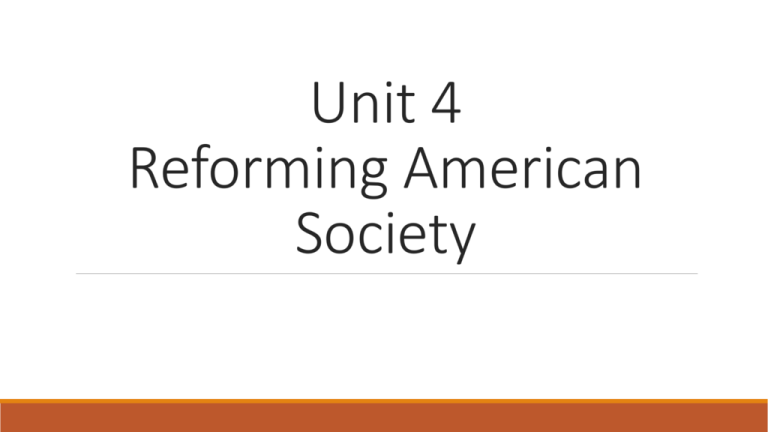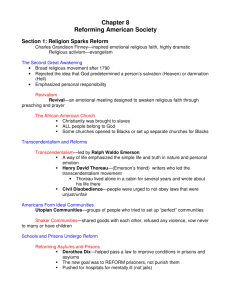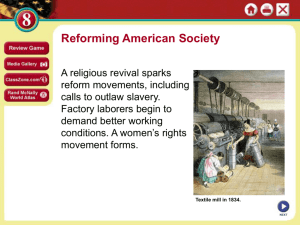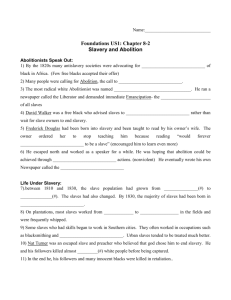Unit 4 Reforming American Society
advertisement

Unit 4 Reforming American Society Think about society today – what elements do you think are in need of change? - Write down one institution or concept that you would like to reform - List 5 specific bullet points of actions you would take to reform that institution Religion Sparks Reform DO YOU BELIEVE RELIGIOUS LEADERS SHOULD TAKE AN ACTIVE ROLE IN BRINGING ABOUT SOCIETAL CHANGE? WHY OR WHY NOT? The Second Great Awakening - Broad religious movement that swept the U.S after 1790 and into the early 1800s ◦ Rejected predestination ◦ Emphasized individual responsibility for seeking one’s own salvation ◦ Insisted that people can take action to improve themselves AND society ◦ Democratic God – one who extends possibility of salvation to ALL people ◦ Revivals – outdoor camp meetings ◦ large gatherings (up to 20,000) ◦ Very emotional/dramatic (shouts, crying, fainting, etc.) ◦ Can last 4-5 days nd 2 Great Awakening - Swept across America – early 1800s - Especially strong in W. NY – burned over district - Tremendous growth in local church congregations and in people who went to church - 1/15 Americans belonged to church in 1800. 1/6 in 1850. Charles Grandison Finney - Most famous preacher of the time - Traveled by horse back throughout countryside to deliver his message - High emotion/high drama - Converts duty = spread the word to others (evangelism) - Religious activism part of larger reform movement Charles Grandison Finney – act on your own free will to give yourself to God Religion and Reform – go hand and hand African American Churches - Democratic impulse of 2nd GA impacted slaves. Strong impulse that all people – black/white belong to God - Northeast – many free African Americans worshipped in separate black churches ◦ AME – African Methodist Episcopal Church ◦ Black churches became – political, cultural, social center for the black community – provided schooling and other services denied blacks ◦ Involved in abolitionist movement - South – slaves were segregated by pew, but heard the same preachers, worshipped in the same church, sang the same hymns as slave owners - Slaves interpreted the Christian message as a promise of freedom and deliverance ◦ Focused on Old Testament stories of deliverance through great miracles (Moses and the Israelites) – God will remember and deliver His people Transcendentalism - A philosophical and literary movement that emphasized ◦ ◦ ◦ ◦ ◦ Living a simple life Celebrating nature and the truth found there Personal emotion and imagination Valued the individual – listen to inner voice Championed – optimism, freedom, self-reliance ◦ Ralph Waldo Emerson – New England writer – leading Transcendentalist Transcendentalist – Henry David Thoreau - Friends with Emerson - Abandoned community life – built a small cabin on shore of Walden Pond near Concord, MA – where he lived alone for 2 years ◦ Follow your inner voice ◦ Individual conscience – civil disobedience – don’t obey laws you think are unjust. Don’t protest with violence but peacefully refuse to obey unjust laws ◦ Ex: Thoreau opposed slavery and war with MX – he refused to pay taxes and went to jail Replica of Thoreau’s small cabin and statue of him on Walden Pond What would a follower of transcendentalism look like today? - What would they do or not do? - What would they have or not have? Utopian Communities - Religious groups inspired by spirit of optimism and social reform – tried to establish a utopia – or perfect place -Tried to achieve self-sufficiency -Most utopian communities only last a few years -Ex – Brook Farm – near Boston – est by transcendentalist George Ripley. Goal – “to prepare a society of liberal, intelligent, and cultivated persons whose relations with each other would permit a more wholesome and simple life than can be led amidst the pressure of competitive institutions.” -Nathaniel Hawthorne lived at Brook Farm for 6 months. He hoped to find solitude to write but found himself working 8-10 hours a day in fields and barn. He left and considered the life “unnatural and unsuitable” for him. Later wrote a novel – fictional account of communal life based on Brook Farm. Other Utopian Communities ONEIDA COMMUNITY - Religious commune founded by John Humphrey Noyes in Oneida, NY - Believed Jesus had already returned in 70 AD - Perfectionism – free of sin in this life - Free love – complex marriage – open relationships - Children raised communally SHAKERS - Followed Ann Lee - founded in England – brought to NY and New England in America - Off shoot from Quakers – “Shaking Quakers” - Shared goods with each other - men and women equal - refused to fight for any reason - pacifism - vow of celibacy - not to marry or have children - dependent on converts and adopting children to keep communities going School and Prison Reform Asylums and Prisons – Dorothea Dix - crusade to improve health care conditions for the mentally ill - horrified to discover many jails housed mentally ill - prisoners confined in cages, pens, chained, beaten with rods - 1840s/1850s - persuaded several states to set up public hospitals for the mentally ill - Dix and subsequently prison reformers emphasized ◦ Idea of rehabilitation – help the person get better so they can take a useful position in society ◦ Humane treatment School Reform - School conditions varied across regions - MA and VT only states with compulsory ed - Classrooms not divided by grade - Few kids go to school past 10 - 1830s – Movement for tax supported public ed - Horace Mann – 1st Secretary of the Massachusetts Board of Education ◦ Established teacher training programs ◦ Instituted curriculum reform ◦ Doubled the money the state spent on schools Abolitionist Movement American Colonization Society - Founded 1816 – repatriate free blacks back to Africa - 1821 Founded Liberia – Latin for land of the free – to be colonized by free blacks - Over the years the society assisted 13,000 to return to Liberia - received some Congressional money and fund raising by selling membership (supported by Henry Clay) - Differing motives ◦ Free blacks cause “perpetual excitement” among slaves ◦ Blacks and whites cannot live together ◦ Some abolitionists – pure motive to return African Americans to Africa/freedom ABOLITION - 1800s African Americans were increasingly joined by whites in public criticism of slavery - Call to outlaw slavery – “a great national sin” - William Lloyd Garrison – radical abolitionist ◦ Started own newspaper The Liberator in 1831 – means to deliver message calling for immediate emancipation ◦ Free the slaves with no payment to slaveholders ◦ Garrison attacked churches and government for failing to condemn slavery ◦ Founded New England Anti Slavery Society in 1832 ◦ Founded national American Anti-Slavery Society in 1833 David Walker - Walker was a free black man - 1829 published Appeal to the Colored Citizens of the World - advised blacks to fight for freedom rather than wait for slave owners to end slavery - “the man who would not fight ought to be kept with all of his children or family, in slavery, or in chains to be butchered by his cruel enemies” Frederick Douglass - Born into slavery – taught to read and write by his master’s wife - Douglass realized education would be his “pathway from slavery to freedom” - In the North becomes the most famous abolitionist – teams up with William Lloyd Garrison and becomes famous lecturer in the antislavery movement - Started his own anti-slavery newspaper, The North Star https://www.youtube.com/watch?v=0Hi4jIZg0cI Nat Turner’s Rebellion - 1831 - Nat Turner – slave in Southampton, VA - Gifted preacher – believed God chose him to lead his people out of bondage - Turner judged eclipse of the sun - divine signal - 80 followers – attacked 4 plantations and killed almost 60 whites before being captured by state and federal troops - Turner escaped and evaded capture for 6 weeks - Tried and hanged - White retaliation – kill up to 200 blacks (some innocent) for connection to the uprising Slavery in th 19 century America -25-30% of Southerners owned slaves ◦ Large Plantations = 20+ claves – about 12% ◦ Small Farm slave owners = few slaves – 15-18% ◦ How would their experiences be different? Pros and cons of each? ◦ 70-75% white Southerners – no slaves – poorer yeoman farmers ◦ Vast majority of slaves ◦ Live on large plantations – overseer ◦ By 1800s most native born Only restriction – cannot kill a slave without good cause – wide variation of experience based on owner Southern Slave Holders Dig In - Slave owners use Bible to defend “the peculiar institution” – passages about servants obeying masters - Contrast image of a happy, well cared for slave (like member of the family, cared for in old age) on a Southern plantation with a free Northern wage slave – worked long hours, in dark factories, for mere pennies and still could barely survive -Rebellions lead to tighter/stricter controls by whites – slave codes ◦ Blacks cannot preach or hold own religious meetings unless “respectable” slave holders are present ◦ Free blacks cannot vote ◦ Free blacks cannot own guns, purchase alcohol, assemble in public or testify in court ◦ Blacks could not own property in some Southern cities Women and Reform What, if any, difficulties do you think women face in the workplace or in other areas of society today? Cult of Domesticity - Women in early 1800s have few options – restrict activities to marriage, home, and family - Only 1 – 5 women had worked outside the home for wages by 1850 - Earn half the pay of men for the same job - Can’t vote - Can’t sit on jury - When she marries, her property becomes her husband’s Women were active in almost all of the reform movements of the early 1800s Seneca Falls Convention - Elizabeth Cady Stanton and Lucretia Mott meet at the World Anti-Slavery Convention in 1840 – both offended that women not allowed to participate http://www.biography.com/people/elizabeth-cady-stanton-9492182#synopsis - Vow to partner to advocate for rights of women - 1848 – Seneca Falls Convention (NY) – planned and run by women) – 300 men and women attend Declaration of Sentiments ◦ https://www.youtube.com/watch?v=pFOieRHRzh8 School House Rock – Women’s Suffrage Movement Sojourner Truth - Born into slavery in NY, but became legally free when slavery was abolished in NY in 1827. - Deeply spiritual, Truth became a travelling preacher and advocated for abolition, pacifism, and equality - Deep, thunderous voice and powerful speaker (few people knew she was illiterate) - for 40 years she travelled and spoke extensively for reforms for women and blacks https://www.youtube.com/watch?v=kRD-CTYFsek Women in Reform - Abolition – Sarah and Angelina Grimke – sisters and daughters of wealthy,, prominent SC slaveholder. Left the South, lived their adult lives in the North and advocated against slavery. Angelina wrote An Appeal to Christian Women of the South, where she called upon women to “overthrow this horrible system of oppression and cruelty.” Grimke sisters also ran a school for girls and advocated for women’s education. Sue Monk Kidd – “The Invention of Wings” - Women and Health Care – Elizabeth Blackwell – first woman to graduate from medical school. Opened NY Infirmary for Women and Children. Advocated for better health care for women Women and Temperance Prohibit consumption of alcohol See drunkenness as serious problem 1825 – American Temperance Society founded Later – almost 100 years later – 18th amendment passed Prohibition Work Place Reform Industry expands in the North ◦ New jobs for unskilled workers ◦ Tedious, boring, repetitive work ◦ Long hours ◦ Low pay ◦ Many factories cramped, unhealthy, dark, poorly ventilated ◦ Overseers often nailed windows shut to keep humidity in (good for threads) Textiles New England – Lowell Mills Mill Girls – In 1828 women made up 9/10 of work force in the textile mills and most were under 30 Live in crowded company owned boarding houses Women get lower wages than men What would you do if you didn’t like the conditions of your job and felt like they were unfair? Worker’s Strikes Between 1836 and 1850 Lowell owners tripled the number of spindles and looms but only hired 50% more workers to operate them. Then in 1834 Lowell mills announced a 15% pay cut. - 800 Lowell girls strike - “Union is Power!” – girls refuse to return to work until wages returned to status - Strike again in 1836 over an increase in board charges Owners prevail but sets precedent of worker organization - National Trades’ Union – trade union from specific trades (carpenters, shoemakers, weaving, etc.) begin to join together into one large organization (1834) Strike Breakers Owners often prevail in 1830s because continual wave of immigrants willing to work for low wages – fire strikers and hire immigrants to work - - Most immigrants in 1830-1860 – German or Irish – go to N. cities for factory jobs - Irish potato famine – over 1 million left Ireland for America ◦ Targets of prejudice ◦ Roman Catholic ◦ Poor ◦ American workers resented their strike breaking American Land https://www.youtube.com/watch?v=QqujfOYmM_A Bruce Springsteen’s American Land What is the narrative that the song tells? Do you think it is an accurate story? Why or why not? What countries did immigrants come from? What type of work did they do? Map – Irish Immigration Settlement in America 1870








